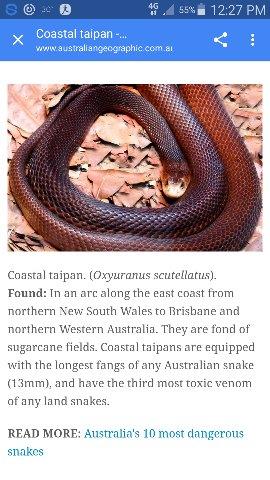Heatho said:
Most Aussie venomous snakes have hollow fangs, my herpetologist mate who works at Taronga Zoo told me they are hollow like a syringe needle, also showed me his fang collection, they were all hollow. I mentioned grooved fangs to him and he said it's generally a myth.
Not strictly correct - there is so much mythology on this and other sites that I will explain, as I did so on this site previously.
types are a normal or a large tooth (non-venomous), grooved tooth (venomous, but generally smaller and rear-fanged, which means unable to get a good penetration on humans in many cases) and hollow tooth (venomous, large and front-fanged - very efficient delivery system)
Many Australian snakes are back-fanged and most are grooved (eg mulga snake) - the tooth wraps around the groove to a high degree, so if a direct bite into flesh only a tiny bit will spill, if biting through clothing etc perhaos a litle more - but still pretty efficient
However even hollow fangs, typical of many overseas snakes like cobras and mambas and adders with large, hollow front fangs, have an entry and exit vent - it is not in the tip (unfortunately in some of our groove-fanged snakes it is fairly close), so if a snake has trouble penetrating (eg gaiters) by no more than the tip, little or none will get into you. And I don't think any snake would bite through my leather gaiters (don't buy fabric hiking gaiters). The fact that we average three deaths per year and India 50,000 despite ours having some of the most toxic venom, is telling you something (obviously population density, urban population etc are factors as well).
However gaiters and stomping hard on the ground to warn the snake with vibration beats getting bitten and wondering about toxicity and delivery efficiency - and being able to collect the culprit (dangerous), photograph it (improbable) or treat the wound properly will reduce the chances of death to near-negligible. The last consists of NOT washing the bite site, and winding a tight roller bandage wound firmly around the bite and up the limb away from it (but not enough to completely prevent circulation, just to prevent rapid distribution through tissues, capillaries and snmall veins into major veins). The site and the bandage can then be tested at the hospital to determine the type of venom and determine the best treatment.







